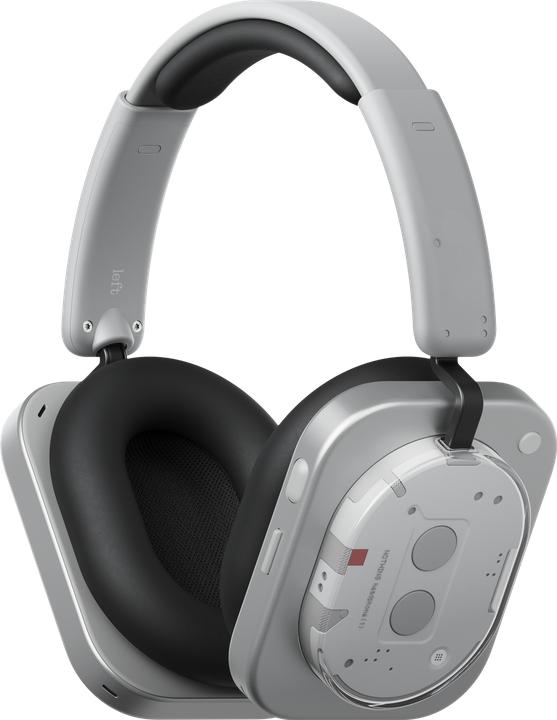

Nothing Headphone (1) review: a great-sounding fidget toy
Nothing has brought its first pair of over-ear headphones, the Headphone (1), onto the market. I’m impressed by the audio and noise cancellation, plus I really like the controls. My only quibble is that my ears overheat too quickly when I’m wearing them.
Nothing has now launched a striking set of over-ear headphones: the Headphone (1). Their numerous controls, which give them a fidget-toy feel I’m fond of, set them apart from Sony’s flagship WH-1000XM6 headphones. However, not everyone will be keen on the fact you can’t fold them.
Controls: roll it, tilt it, press it
While my colleague Florian Bodoky has been gushing over the [Sony WH-1000 XM6](/page/sony-wh-1000-xm6-ihre-faltige-hoheit-ist-wieder-da-37955 for being almost entirely touch-controlled, I like exactly the opposite in Nothing’s Headphone (1). In addition to buttons, the headphones have four different tactile control elements:
- A slider for switching them on and off
- A roller for the volume, which you press to switch between noise cancellation and transparency mode
- A paddle for skipping songs
- A button to activate the voice assistant
I can feel every control element on the headphones precisely. No more guessing where exactly I have to touch or how many times I have to tap for which function. I’m a fan.
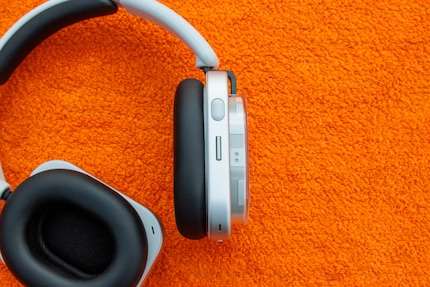
If you use the Headphone (1) in tandem with the Nothing Phone (3), you’ll get access to an additional feature. Holding down the voice assistant button allows you to record a voice note that’ll be saved into Essential Space. This, incidentally, is Nothing’s app for collecting screenshots and voice memos, which it organises using AI. Although the feature will be available on other Nothing smartphones, only the Phone (3a) and (3a) Pro have Essential Space as well. Since older devices don’t have the roller button, they won’t get the app.
The Headphone (1) over-ears have a very striking design. You’ll definitely stand out when you’re wearing them. The manufacturer has set its new model apart from the mass of over-ears on the market. Weighing 329 grammes, the headphones sit comfortably and don’t pinch – even over my glasses. Their only drawback is that my ears overheat too quickly when I’m wearing the Headphone (1). Just 20 minutes into a leisurely stroll in the shade at around 20 degrees Celsius, my ears start to get damp, even though the rest of my body isn’t sweating yet. On the other hand, when I’m sitting comfortably at my desk, it takes longer for my ears to overheat.

You can’t fold up the Headphone (1) over-ears for transport. The headband is fixed in place and the included carry case is suitably bulky. Although the recesses on the case feel nice on your fingers, I can’t say the same for the zip. It’s stiff and looks flimsy.
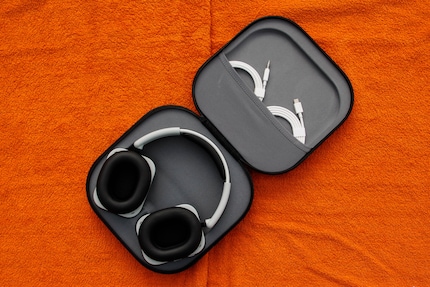
The Nothing Headphone (1) over-ears are IP52-certified against dust and water droplets. Light rain is no match for the headphones, but you shouldn’t expect them to withstand more moisture than that.
Significant variations in battery life
The Headphone (1) over-ears sport a 1,040 mAh battery. This allows them to achieve 35 to 80 hours of playback time. How much juice you’ll actually get will depend on which codecs you’re using and whether you have active noise cancellation switched on. It takes about 120 minutes to charge the battery. The headphones come with a USB-C cable, but you’ll need to buy a power adapter separately if you don’t already have one.
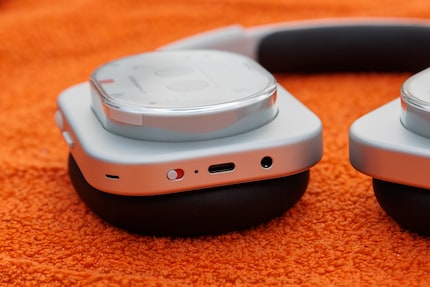
Excellent sound, with new details to discover
When it comes to the sound of its first over-ears, Nothing enlisted the help of KEF, a British company that’s been manufacturing speakers and headphones for over 60 years. The result of their collaboration is a 40-millimetre driver made from foam rather than solid plastic in the middle. This supposedly makes sound resonate better and hit lows more powerfully. A nickel-coated diaphragm is supposed to provide greater clarity in the treble range.
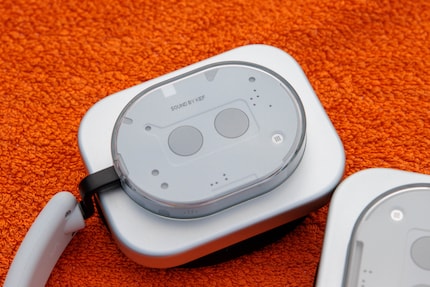
You can connect the Headphone (1) over-ears via a jack cable (3.5 mm) or wirelessly via Bluetooth 5.3. The wireless headphones support Dual Connection, meaning you can connect two devices simultaneously and switch seamlessly between, say, your computer and your phone. They also support three different codecs: AAC, SBC and LDAC (hi-res audio).
However, even with conventional streaming, the headphones come up trumps with a polished, clear sound. I can hear details that are lost with other headphones – even using Spotify, without having to resort to uncompressed files.
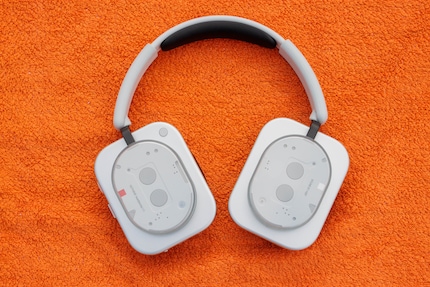
The advantage of not pushing the bass to its limits is that the treble stays refined and doesn’t get drowned out. Mids are pleasantly balanced and blend into a well-rounded sound. Even listening to an eclectic variety of music, the headphones don’t show any weaknesses. They cope with a variety of genres and their idiosyncrasies. When I listen to audiobooks, background noises I hadn’t noticed before come to light.
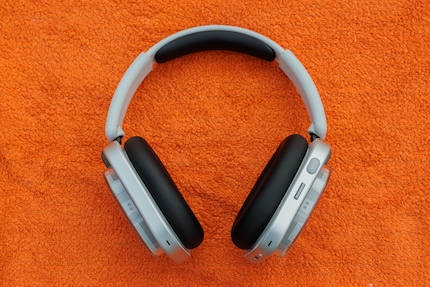
The Nothing Headphone (1) over-ears have bass amplification. This can be used to strengthen the bass in five stages. I gave it a go, sticking to the halfway point. Level four or five would be too intense for me. You can make additional sound adjustments using an eight-band equaliser in the Nothing app.
Spatial audio works with a wide variety of sound sources. The headphones determine which direction a sound is coming from. So depending on which way you move your head, the sound will come from a clearly recognisable direction. I haven’t decided whether I like it yet.
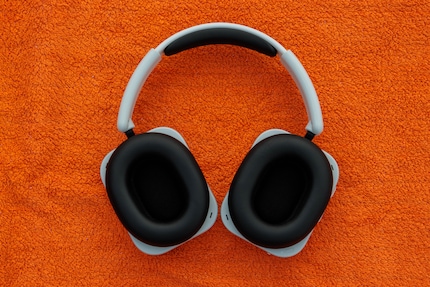
Less noise, better sound
The Headphone (1) over-ears have good active noise cancellation (ANC), with the feature reducing background noise by up to 42 decibels. Obviously, that’s not always enough to create complete silence. Even so, it allows you to hear the audio clearly without having to crank the volume up high. When I try it on an aeroplane, for example, the flight feels much quieter. At the office, the headphones silence all the background noise. Voices, however, come through loud and clear. That can be a good thing (say, when there’s an announcement on the train) or a bad thing (for example, when your colleagues or people sitting next to you on public transport are chatting).
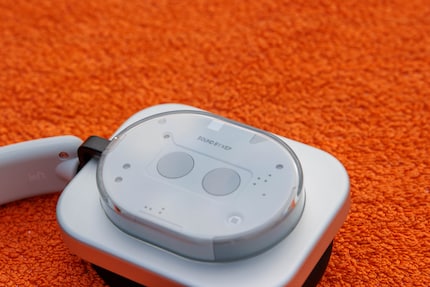
Every 600 milliseconds (ms), the Headphone (1) over-ears scan their surroundings and use ANC to neutralise any noises they detect. Every 1,875 ms, the headphones check whether they’re still sitting correctly or whether adjustments need to be made to the ANC as a result of small gaps around your ear. I notice this when I’m chewing something and my jaw moves, shifting the position of the headphones.
With transparency mode, the Headphone (1) over-ears also offer the opposite of noise cancellation. If you activate it, you’ll be able to hear your surroundings without taking off the headphones.
App for fine-tuning
The Nothing X app gives you access to an equaliser, where you can adjust any settings you can’t change on the headphones directly. For example, you can specify how strong you want the ANC to be. You can also switch the feature off rather than simply having the headphones switch between the ANC and transparency mode. Plus, you can turn on Spatial Audio, Dual Connection and Bass Enhance.
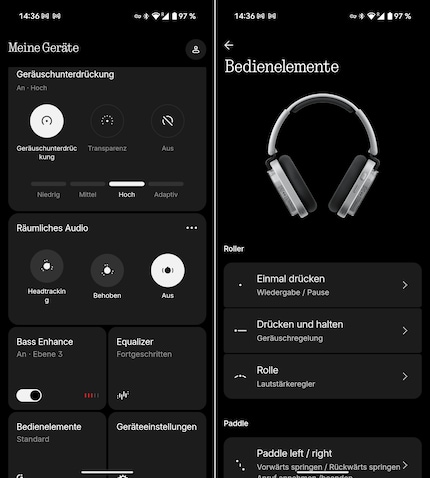
You can also use the app to change the assignment of the controls, select a codec or switch on low-latency mode. If you want the playback to stop automatically when you take the headphones off, you have to activate over-ear detection in the app. Naturally, you can find both equalisers in the app too.
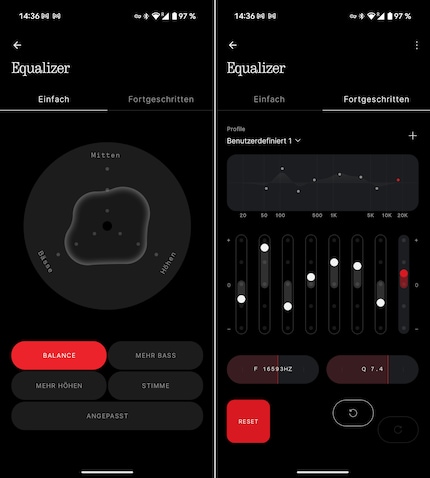
The Headphone (1) will be available for pre-order from 4 July. The headphones officially go on sale on 15 July.
In a nutshell
Good audio, fun controls and long-lasting battery
Nothing’s Headphone (1) over-ears impress me with their excellent, customisable sound. I also really like the tactile controls, which I personally find more intuitive than touch controls. As long as you don’t consider yourself an audiophile, the supported standards and codecs are more than up to scratch. If you use the headphones in tandem with the Nothing Phone (3), you’ll have special recording methods at your disposal.
However, some aspects of Nothing’s first over-ear headphones fail to win me over. Since they aren’t foldable, they take up more space in your rucksack. Not only that, but the zip on the case looks flimsy and catches easily. Your ears quickly get too hot under the Headphone (1) ear cups, making them less comfortable to wear.
For headphones of this price, you get good sound quality, an eye-catching design and fun controls.
Pro
- Self-explanatory controls
- Decent sound
- Long battery life
Contra
- Not foldable
- Your ears get hot when wearing them
- Case zip is flimsy and prone to catching

As a primary school pupil, I used to sit in a friend's living room with many of my classmates to play the Super NES. Now I get my hands on the latest technology and test it for you. In recent years at Curved, Computer Bild and Netzwelt, now at Digitec and Galaxus.


